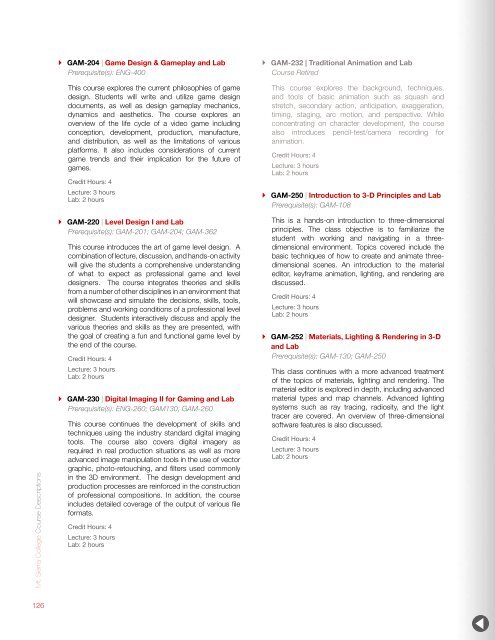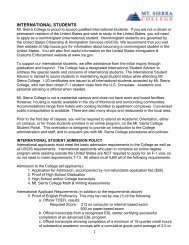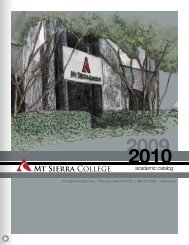Academic Catalog - Mt. Sierra College
Academic Catalog - Mt. Sierra College
Academic Catalog - Mt. Sierra College
You also want an ePaper? Increase the reach of your titles
YUMPU automatically turns print PDFs into web optimized ePapers that Google loves.
<strong>Mt</strong>. <strong>Sierra</strong> <strong>College</strong> Course Descriptions<br />
126<br />
` GAM-204 | Game Design & Gameplay and Lab<br />
Prerequisite(s): ENG-400<br />
This course explores the current philosophies of game<br />
design. Students will write and utilize game design<br />
documents, as well as design gameplay mechanics,<br />
dynamics and aesthetics. The course explores an<br />
overview of the life cycle of a video game including<br />
conception, development, production, manufacture,<br />
and distribution, as well as the limitations of various<br />
platforms. It also includes considerations of current<br />
game trends and their implication for the future of<br />
games.<br />
Credit Hours: 4<br />
Lecture: 3 hours<br />
Lab: 2 hours<br />
` GAM-220 | Level Design I and Lab<br />
Prerequisite(s): GAM-201; GAM-204; GAM-362<br />
This course introduces the art of game level design. A<br />
combination of lecture, discussion, and hands-on activity<br />
will give the students a comprehensive understanding<br />
of what to expect as professional game and level<br />
designers. The course integrates theories and skills<br />
from a number of other disciplines in an environment that<br />
will showcase and simulate the decisions, skills, tools,<br />
problems and working conditions of a professional level<br />
designer. Students interactively discuss and apply the<br />
various theories and skills as they are presented, with<br />
the goal of creating a fun and functional game level by<br />
the end of the course.<br />
Credit Hours: 4<br />
Lecture: 3 hours<br />
Lab: 2 hours<br />
` GAM-230 | Digital Imaging II for Gaming and Lab<br />
Prerequisite(s): ENG-260; GAM130; GAM-260<br />
This course continues the development of skills and<br />
techniques using the industry standard digital imaging<br />
tools. The course also covers digital imagery as<br />
required in real production situations as well as more<br />
advanced image manipulation tools in the use of vector<br />
graphic, photo-retouching, and filters used commonly<br />
in the 3D environment. The design development and<br />
production processes are reinforced in the construction<br />
of professional compositions. In addition, the course<br />
includes detailed coverage of the output of various file<br />
formats.<br />
Credit Hours: 4<br />
Lecture: 3 hours<br />
Lab: 2 hours<br />
` GAM-232 | Traditional Animation and Lab<br />
Course Retired<br />
This course explores the background, techniques,<br />
and tools of basic animation such as squash and<br />
stretch, secondary action, anticipation, exaggeration,<br />
timing, staging, arc motion, and perspective. While<br />
concentrating on character development, the course<br />
also introduces pencil-test/camera recording for<br />
animation.<br />
Credit Hours: 4<br />
Lecture: 3 hours<br />
Lab: 2 hours<br />
` GAM-250 | Introduction to 3-D Principles and Lab<br />
Prerequisite(s): GAM-108<br />
This is a hands-on introduction to three-dimensional<br />
principles. The class objective is to familiarize the<br />
student with working and navigating in a threedimensional<br />
environment. Topics covered include the<br />
basic techniques of how to create and animate threedimensional<br />
scenes. An introduction to the material<br />
editor, keyframe animation, lighting, and rendering are<br />
discussed.<br />
Credit Hours: 4<br />
Lecture: 3 hours<br />
Lab: 2 hours<br />
` GAM-252 | Materials, Lighting & Rendering in 3-D<br />
and Lab<br />
Prerequisite(s): GAM-130; GAM-250<br />
This class continues with a more advanced treatment<br />
of the topics of materials, lighting and rendering. The<br />
material editor is explored in depth, including advanced<br />
material types and map channels. Advanced lighting<br />
systems such as ray tracing, radiosity, and the light<br />
tracer are covered. An overview of three-dimensional<br />
software features is also discussed.<br />
Credit Hours: 4<br />
Lecture: 3 hours<br />
Lab: 2 hours<br />
` GAM-254 | Lighting for Games and Lab<br />
Course Retired<br />
This course examines the various techniques used to<br />
create both real and simulated lighting in games. The<br />
limitations of real lighting in games will be discussed,<br />
and the student will study simulation techniques<br />
including vertex coloring and texture baking. Advanced<br />
three-dimensional lighting concepts such as global<br />
illumination will be explored in conjunction with texture<br />
baking to create sophisticated lighting simulations.<br />
Credit Hours: 4<br />
Lecture: 3 hours<br />
Lab: 2 hours<br />
` GAM-260 | Environmental Modeling and Lab<br />
Prerequisite(s): GAM-250<br />
In this course, the student begins to build actual game<br />
environments. Techniques for building and texturing<br />
structures and terrain are discussed. The student will<br />
create both indoor and outdoor game levels and worlds.<br />
Construction of these worlds will conform to standard<br />
industry practices.<br />
Credit Hours: 4<br />
Lecture: 3 hours<br />
Lab: 2 hours<br />
` GAM-280 | Digital Compositing I for the PC and<br />
Lab<br />
Course Retired<br />
This course, through lecture and hands-on exercises,<br />
covers the skills necessary to enhance video through<br />
compositing and image editing. The process of<br />
creating a video production will be covered, including<br />
pre-production, lighting, camera-work, editing and<br />
post-production. The course will also include lectures<br />
and discussions about using industry-standard editing<br />
software.<br />
Credit Hours: 4<br />
Lecture: 3 hours<br />
Lab: 2 hours<br />
` GAM-320 | Level Design II and Lab<br />
Prerequisite(s): GAM-220<br />
This course covers the intermediate techniques to<br />
enhance the gaming experience using simulated<br />
lighting in a game engine as well as functional game<br />
mechanics of the level. Utilizing current game engine<br />
software, students will expand on previous work from<br />
Level Design 1, refining the in-engine level.<br />
Credit Hours: 4<br />
Lecture: 3 hours<br />
Lab: 2 hours<br />
` GAM-350 | Keyframe Animation and Lab<br />
Prerequisite(s): DES-210<br />
This course is an introduction to three-dimensional<br />
animation, beginning with an introduction of how<br />
animation works. The student then learns how to<br />
animate objects in a three-dimensional scene. The<br />
course also covers animation controllers and how to<br />
have a camera follow a path. Other topics include object<br />
linking, animating materials, and a detailed exposition of<br />
animation utilities.<br />
Credit Hours: 4<br />
Lecture: 3 hours<br />
Lab: 2 hours<br />
` GAM-352 | Special Effects and Lab<br />
Course Retired<br />
This course covers the possibilities of adding special<br />
visual effects to a scene and the utilization of effects<br />
in game cinematics, film, television, and Internet<br />
entertainment. Lab exercises will emphasize creating<br />
effects using both digital and traditional techniques;<br />
visual effects history, covering optical effects, models,<br />
animation, matte painting, and physical effects; visual<br />
structure, and visual effects production practices and<br />
workflow.<br />
Credit Hours: 4<br />
Lecture: 3 hours<br />
Lab: 2 hours<br />
` GAM-354 | Alternative Techniques in 3-D<br />
Production I and Lab<br />
Prerequisite(s): GAM-252<br />
This course covers basic illustrations in the threedimensional<br />
environment through the exploration of<br />
other software and tools used in the gaming industry.<br />
Topics include perspective, primitive placement,<br />
modeling, lighting, key-frame animation, and rendered<br />
three-dimensional imaging.<br />
Credit Hours: 4<br />
Lecture: 3 hours<br />
Lab: 2 hours<br />
<strong>Mt</strong>. <strong>Sierra</strong> <strong>College</strong> Course Descriptions<br />
127







